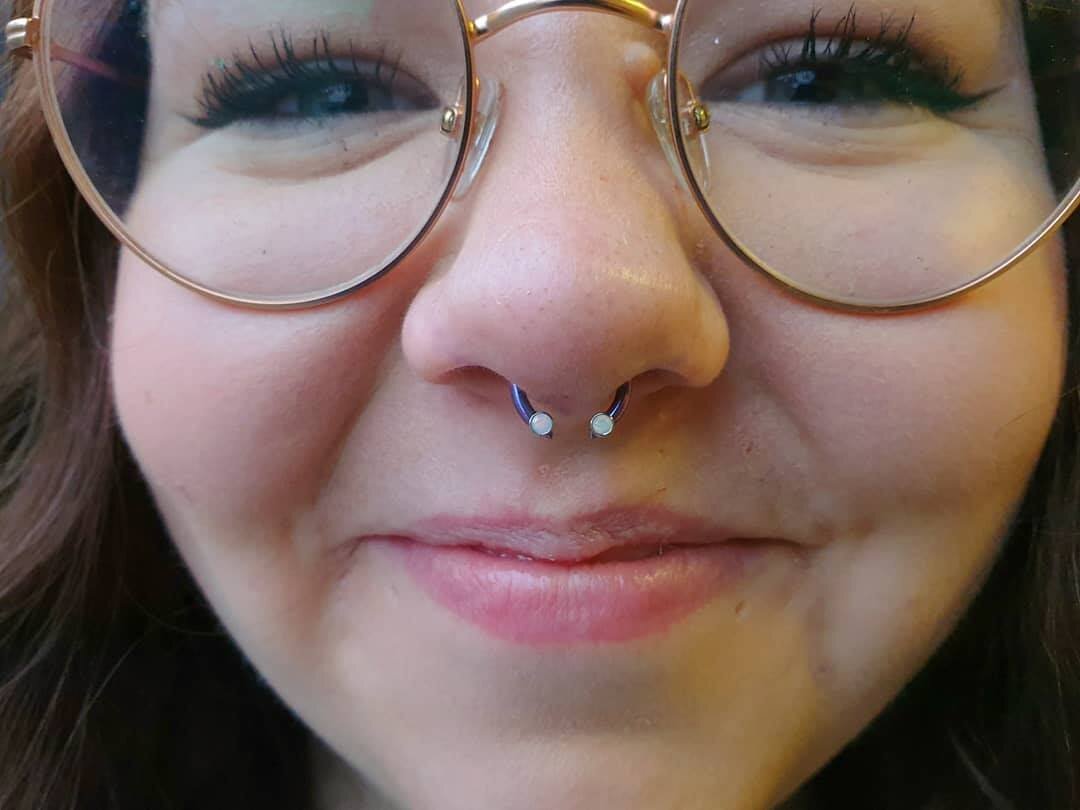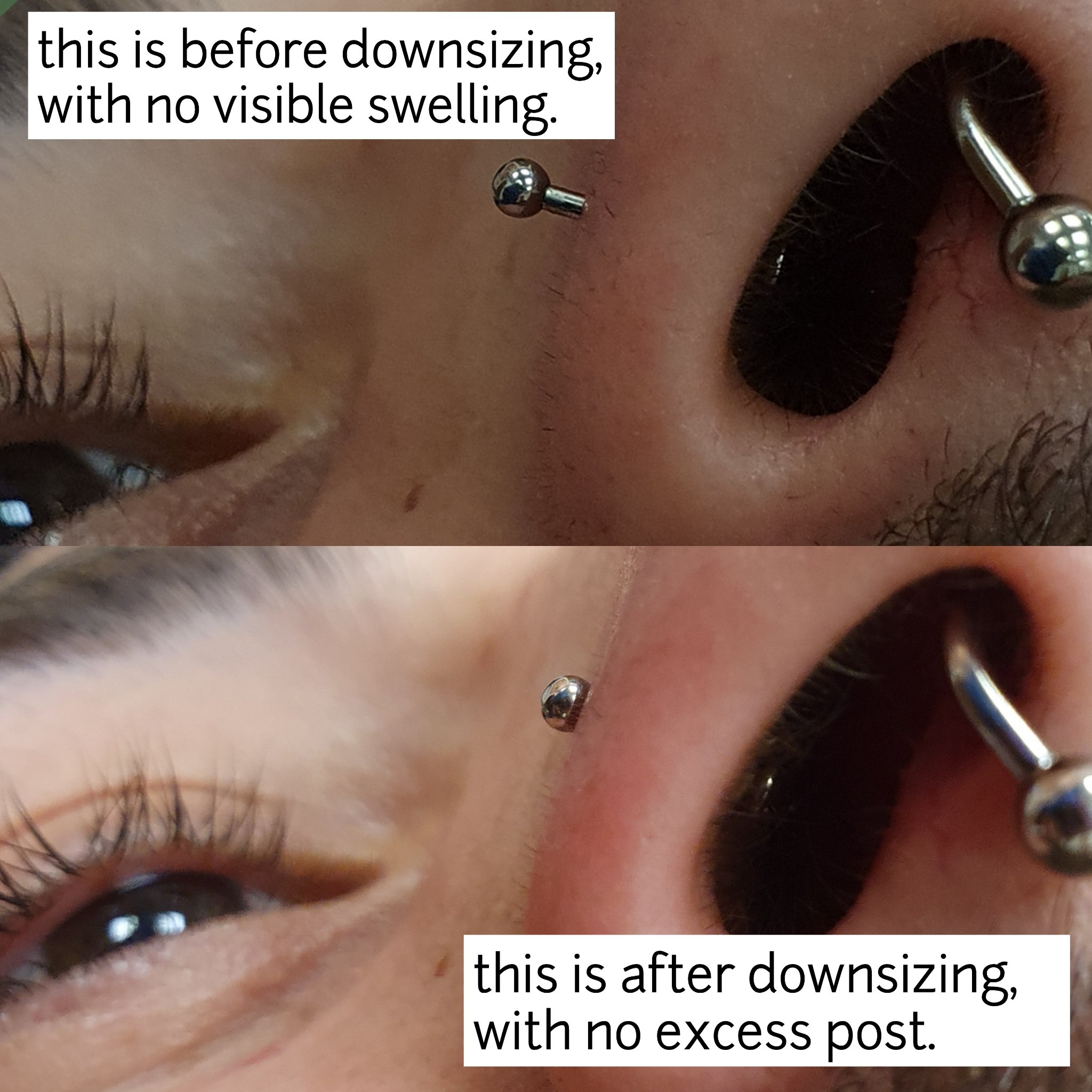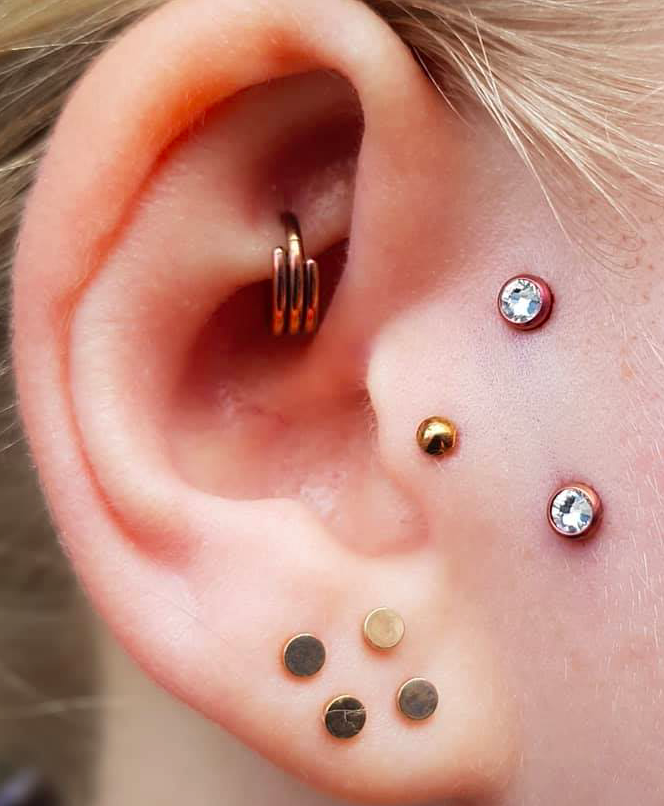What to expect in the early stages of healing…
During the first few weeks of healing, it’s likely that you will experience the following:- Localised swelling, localised pain and tenderness, discharge of a clear our cloudy fluid, bruising and bleeding.
Discharge of a clear or cloudy fluid may persist for several months with slow healing piercings.
These are very normal, you may experience none, some or all to a degree and still have a very healthy piercing. DO NOT touch, pick at, twist or apply cosmetics to your piercing. Please read this page carefully and follow the cleaning instructions listed as advised.
What should I be cleaning my piercing with and how?
Sterile Saline
Sterile 0.9% Saline is an isotonic solution, this means it neither over hydrates or dehydrates your skin, to cause minimum disruption to the wound healing process.
This is why it’s so important to not use soaps, oils and alcohol based products. They are not isotonic and will cause disruption to this type of wound healing.
Wash your hands
You must wash your hands before and after you clean your piercing to prevent the spread of infection. If you do not wash your hands prior to cleaning, you may be actively transferring harmful bacteria onto your piercing as your cleaning it.
Showering
Showering is an excellent way to clean your piercing, the constant stream of clean warm water will help remove dry exudate - the waste material that discharges from your piercing. Be careful not to use a loofah or shower pouf on or around your piercing in case of snagging, they also harbour bacteria.
Downsizing
Some piercings need to be downsized after a few weeks. Initial piercings are often performed with a slightly longer bar so the tissue has room to swell, once that swelling has subsided you must return to the studio to have a shorter bar fitted so your piercing can continue to heal well. Failure on your part to do this can result in lumps, bumps and migration that may not be fixable. Downsizing does not happen on a “set date” as we all heal at our own pace but we will give you an estimate when you get pierced as to what the “average” downsize time is.
Looking at the image here - if your piercing looks like the image on the left and is over a month old it needs to be downsized. Your piercing cannot be downsized if there is no visible shaft.
How often?
Piercings should only be cleaned with sterile saline once or twice a day. Over cleaning will cause disruption to wound healing and under cleaning may cause infection.
How should I apply it?
Test your sterile saline stream by spraying it once into the sink before using it on yourself to help gauge the pressure of the flow - you can usually hold your canister a couple of inches away from your piercing. Concentrate the flow at the piercing exit wounds at the front and the back. It will only take seconds seconds to rinse your piercing. Do not remove your jewellery and DO NOT TWIST YOUR PIERCING as this disrupts the formation of new skin cells, delaying healing and potentially causing a bump.
Drying your piercing
As soon as your piercing as been cleansed whether with sterile saline or in the shower you must gently dry the skin. The best material for this is lint free gauze, which is inexpensive and will not leave little bits of cotton fluff at the wound site. If this is not available to you, you can use cotton wool, disposable kitchen towel, or a cotton bud, whichever you feel is the most accessible to the wound site. DO NOT USE TOILET PAPER as it dissolves on contact with moisture and will leave the most particulate matter on your piercing.
Example of piercing before and after downing has taken place.
Healing tips and tricks…
There are no tricks that will help your piercing heal faster, but you can help your piercing heal easier by doing the following:-
DO return to the shop and have your piercing downsized after a few weeks if you have no swelling and your jewellery is too long.
DO change your bedding regularly
DO wear clean, comfortable lose fitting closing if covering the wound site
DO drink lots of water, dehydration will slow and prevent wound healing
DO rest and eat vitamin rich foods
DO NOT sleep on your piercing until after it is downsizes at the very earliest.
DO NOT go swimming while your piercing is healing or for a minimum of 3 months for slow healing piercings such a cartilage, surface, nipple and navel piercings.
DO NOT touch or allow others to touch your piercing. Handle your piercing only when necessary for aftercare with hands that have just been washed with warm soapy water.
Disinfect regularly any personal items that might come into contact with your piercing regularly such as your glasses. Restrict the use of personal items such as your phone or headphones and disinfect these items regularly. If you have healing piercings on one ear, use your phone on the other ear.
Cut down on drinking and smoking as both of these things slow down the wound healing process and leave you exposed to potential complications for longer.
Complications
DO NOT TOUCH YOUR PIERCING
Non-Emergancy complications
An example of a swollen piercing, this is a piercing that should be checked up on, but it not in a state of emergency.
Piercings are very slow healing wounds. We actually ask a whole lot of the body when we ask it to heal a wound with a foreign object in it that shouldn’t be there.
Complication can occur at anytime and is usually nothing to be worried about but does need to be addressed. You can contact us at anytime with healing concerns about your piercing but please include as much detail as you can - this includes if you’ve done something to your piercing you shouldn’t have - because we can’t help you if we don’t know what’s really happened.
Improperly fitting jewellery
If you have not had your jewellery downsized when you were advised this can cause real problems. If your jewellery is too big you will catch it more, causing redness and bumps. It will become sore to sleep on and may migrate. If extra length on the piercing shaft remains exposed once your initial swelling has gone down, dirt will build up on that portion of the jewellery and can be tracked through the piercing causing inflammation, keeping it in a swollen state.
Conversely, wearing jewellery that is too tight can cause cutting and embedding. Many people will desire the “tightest possible fit“, but just like with shoes, the tighter doesn’t always mean the better. Please ensure your jewellery fits comfortably or it can lead to emergency complication.
Lumps and Bumps
Lumps and bumps come in many forms with various causes, the most common cause is the piercing being knocked or the wearer playing with the jewellery. As soon as you notice a small bump forming take a close up, high resolution photo of it and send it to us along with the age of the piercing and any other relevant information and we’ll try our best to help.
Chemical Irritation
Chemical irritation sounds quite severe but it can literally be any product interacting with your piercing that can make it aggravated. Such as household cleaning products, hair dye and other cosmetics. Even working in a smokey or dusty environment. If you are experiencing chemical irritation please flush your piercing area (do not remove your jewellery) with sterile saline or cleaning running water thoroughly, keep hair pinned off of your piercing and/or wear loose fitted comfortable clothing and change your bedding. The problem should resolve itself within a few days but be vigilant not to repeatedly expose your piercing to an irritant you know to be harmful as it may lead to infection.
Emergency complications
severe swelling and Embedding
Embedding is when your piercing has become extremely swollen and the jewellery is sinking into the skin. It is normal for your piercing to swell to the full size of your starter jewellery - however if it is actually sinking into and underneath your skin you must return to the studio immediately to have longer jewellery installed. If you are unable to return to the studio for any reason you can try the following things:
Icing your piercing - like any swelling injury, icing may help reduce inflammation particularly if you have experienced trauma to the piercing site. When icing, remember to wrap your ice pack in a clean towel or casing, preventing direct skin contact, and do not ice your piercing for more than 20 minutes per hour.
Anti-inflammatories - Over the counter anti-inflammatories that can be purchased at any pharmacy can be taken in accordance with the manufacturers instructions and any additional medical guidance given by your doctor or pharmacist. Do not take anti-inflammatories if you know or suspect yourself to be allergic or if they contraindicate any medical condition you have. We do not recommend the use of any topical agents applied directly on to your skin.
Retire your piercing - this may not be a favourable option for many but piercing is cosmetic only and this is an option if your piercing is causing you distress. Please ensure both the skin surrounding your piercing and your hands have been cleaned before doing this or wear a fresh pair of nitrile exam gloves.
Infection
Most bacterial infections are mild enough that your own healthy immune system is strong enough to fight them off, but in rare cases infection can overwhelm the immune system and become serious, requiring medical intervention as soon as possible.
Signs of potential infection are extreme heat, redness spreading outward from the wound site, extreme swelling, severe pain, thick green or yellow discharge seeping from the piercing, nausea or a fever and swollen lymph nodes.
Severe infection is rare and it’s even rarer when you follow the correct aftercare and practise regular hand washing, however it is possible.
If you suspect you have an infection, contact your GP or NHS 24 on 111 who can arrange an appointment with an out of hours GP with you.
If you do not feel your piercing is in a state of emergency, you can take high resolution photographs of it and email them to us or book in for a check up with us as soon as possible. We are not medical professionals and we can’t say if you have an infection or not but we can tell you if something looks like a cause of concern or is a normal amount of swelling.
If you feel your piercing is in a state of emergency and you are experiencing multiple signs of infection particularly a fever, please seek emergency medical assistance by dialling 111.






